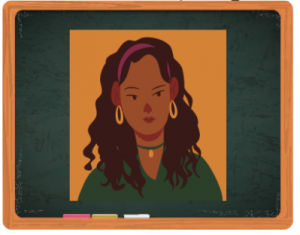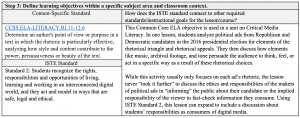2.2: Defining Learning Objectives
Directions
In this section and in 2.3, we will complete the second phase of the ISTE Unpacking Process: Determination of Objectives.
Reminder: To complete this task, you will need to download and use your own copy of: ISTE Standard Unpacking Process Graphic Organizer – BLANK. Fill in each corresponding section of this document as it is discussed below.
 Checking in with Ms. Franklin: Ms. Franklin’s unpacking process will serve as a model as you go through the steps yourself. To see a completed version of her unpacking process, download the ISTE Standard Unpacking Process Graphic Organizer – COMPLETED SAMPLE.
Checking in with Ms. Franklin: Ms. Franklin’s unpacking process will serve as a model as you go through the steps yourself. To see a completed version of her unpacking process, download the ISTE Standard Unpacking Process Graphic Organizer – COMPLETED SAMPLE.
In this section, you will see Ms. Franklin begin to incorporate the ISTE Student Standards into her curriculum by selecting a Common Core English Language Arts Standard and explain how she can connect her two chosen standards into an existing lesson for her course. She will then craft new learning objectives and criteria for achieving proficiency of the standard for her individual classroom context.
Step 3: Defining Learning Objectives within a Specific Subject Area and Classroom Context
The third step in the unpacking process is to define learning objectives within a specific subject area and classroom context.
To do this, you first need to select a subject-area specific standard that aligns well with the ISTE Standard and/or an existing lesson or unit for your course. Some questions you might consider when making this decision are:
- What existing activities, content, lessons, or units in my current curriculum provide an opportunity for students to learn the knowledge and skills suggested by the ISTE standard? How could I redesign an existing activity, lesson, or unit to “take it a step further” to incorporate these skills and knowledge?
- If you’re struggling to find an existing activity, lesson, or unit, consider using the remainder of the unpacking process to brainstorm a new instructional idea for students to achieve your standard. Feel free to peruse your favorite instructional-related websites for ideas.
Let‘s see how Ms. Franklin did it. She originally chose ISTE Standard 2 for her unpacking process:

After reflecting on how to best connect Standard 2 to other required standards or instructional goals for her course, she decided to incorporate it into a unit she already teaches on critical media literacy. In one particular lesson of this unit, students analyze political ads from Republican and Democratic candidates in the 2016 presidential election for elements of the rhetorical triangle and rhetorical appeals.
While this activity usually only focuses on each ad’s rhetoric, the lesson never “took it further” to discuss the ethics and responsibilities of the makers of political ads in “informing” the public about their candidate or the implied responsibility of the viewer to fact-check information they consume. Using ISTE Standard 2, this lesson can expand to include a discussion about students’ responsibilities as consumers of digital media. See the completed Step 3 from her graphic organizer:
Using Ms. Franklin’s example as a guide, complete Step 3 in your ISTE Standards Unpacking Process graphic organizer.
Up next: Step 4, writing new learning objectives!

